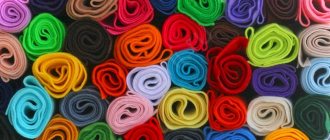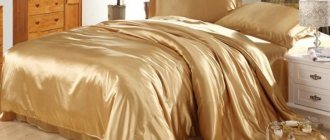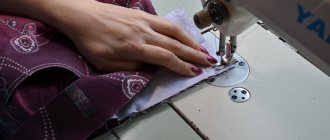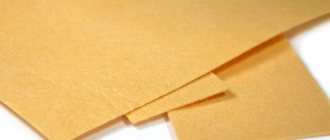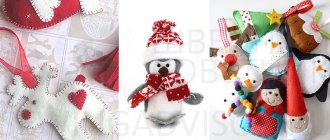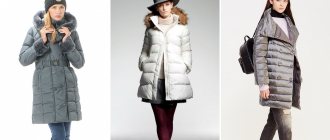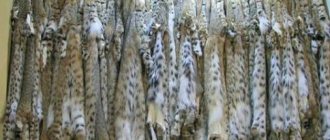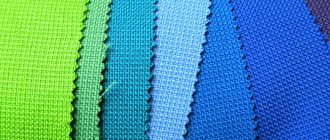Have a good day and good mood everyone! Today we will talk about felt, get acquainted with its main properties, scope of application, and, of course, learn a lot of interesting things. In general, let's go! As always, let's start with associations. As for me, when I hear the word “felt,” I immediately picture in my mind a young French woman in a red felt hat, a black coat and leather boots, walking with a small dog on an autumn day in the park. I don’t know why this particular picture pops up in my head, probably, most likely, from films. By the way, it would be interesting to know your association with felt. Write in the comments, I will be very glad to read it. So, where am I leading with all this? A! In general, later in the article we will find out whether clothes are made from felt, in particular coats and hats. In the meantime, I propose to move on to the history of its origin.
1. The history of felt; 2. Technology for producing felt; 3. Types and properties of felt; 4. Scope of application of felt; 5. Felt care; 6. Customer reviews
The history of felt
I really like to add interesting legends to my articles, here is one of them. In ancient times, about 350 - 400 years ago, nomads who had to travel long distances put animal hair in their shoes for convenience. As you may have guessed, after some time the wool was crushed under the influence of the person’s weight, and a completely different, more durable and comfortable material was obtained. The people quickly mastered this accidental invention and began to use felted wool everywhere to make clothes, carpets, chain mail, roof coverings, etc.
The word “Felt” itself (from the French feutre - felt) means a special non-woven material made by felting down, wool and fur. It is worth noting that at the beginning of the twentieth century in France, only a very wealthy lady could have a felt hat; commoners could not even dream of it.
History of appearance
Mankind was the first to invent woolen fabric, using animal skins and giving the material the necessary properties. Over time, wool fibers began to be felted into a single dense layer, so in the 5th century BC. felt appeared, which was used to insulate the home. The peoples of Asia are considered to be the creators of felted wool products, but it is not known exactly where felt was first made. Expensive felt appeared about four centuries ago, which was the privilege of noble gentlemen. Felt hats, elegant shoes, and decorative elements were made from it.
Felt production technology
As mentioned above, the structure of felt does not have interlacing threads; accordingly, the material belongs to non-woven types obtained by the folding method. By the way, felt is also popularly called felt or yarn after dry felting.
Modern felt production.
Naturally, to produce felt on an industrial scale, automated production has been established around the world. The raw material for making felt is soft wool or fluff collected from animals, most often a goat or a rabbit. Modern materials, of course, contain synthetics and artificial components. What would it be like without them!? During manufacturing, the raw material fibers are moistened with hot steam, then they are heated, and then friction is applied. As a result, sheet material (sheet thickness varies from 0.5 mm to 10 mm) or rolled material up to 220 cm in size comes off the conveyor. It is also possible to see semi-finished products in the form of caps for making hats and thin felt boots. Most often, felt has a single bright color, but it is also possible to add various prints. Interesting! It is worth noting that the color range of felt can reach up to 144 different shades.
Also, felt does not have a front or back side, it is durable and comfortable, the edges of the felt do not crumble and they don’t even need to be processed.
Pure wool felt
This type of felt is also called wool or natural. Beginning craftsmen do not often take such material for needlework, mainly because of its cost. The price fluctuates, just like itself. This is one of the most expensive types of felt. Basically, like everything natural. It makes no sense to take it if you only want to make a keychain or decorate a pillow. It has natural felt and other disadvantages. For example, it may “shrink” after washing, and pellets may form on its surface. Natural felt wrinkles easily and can become shaggy. Professional craftsmen who are not afraid of the disadvantages of wool felt claim that some small products are best made from it - for example, jewelry and toys. This felt can also be used to decorate products.
Types and properties of felt
Depending on the source raw material, the material can be:
- Woolen. Felt of natural origin is made from the wool of a goat, rabbit, sheep, etc. Wool felt is environmentally friendly, has antiseptic properties, and has high thermal insulation. Durable, dense, not afraid of dirt and contact with fire. The disadvantage is the high price, change in shape when water gets in, as well as the unpleasant odor of the wet fabric. Used for crafts, applications, decorations and technical purposes.
- Wool blend . Composition: 50% wool and 50% viscose (possibly adding acrylic). Soft, plastic, cheap, large selection of colors, does not irritate the skin. The main drawback is the tendency to shed and wrinkle.
- Acrylic (artificial). This type is made from recycled plastic. The surface of acrylic felt is distinguished by its shine and long-lasting rich color. Felt is easy to clean (the shape remains unchanged after washing). Unfortunately, man-made fibers make felt unhygienic and prone to fire. A “creaking” effect appears in the work. It is also very slippery in your hands.
- Bamboo . The composition includes bamboo fiber with viscose. It has an antibacterial effect and high strength, and also has a slight shine, silk and soft structure. Very pleasant to the touch. Large selection of colors. The main disadvantage is loss of strength when wet and deformation. It is dry clean only. It has a high cost. It is worth noting that it is very rare in Russia.
- Polyester. Durable enough for long-term use. In light colors it tends to shine through.
- Simulated. Another type of felt that allows you to make products of absolutely any shape. Modeling properties are achieved by special impregnation and wetting of the raw material before work. An important advantage of simulated felt is the absence of deformation during operation.
- Eco-felt. Obtained after processing of secondary raw materials. It can be both soft and hard. Keeps its shape like whatman paper. Thin sheets are uniform in structure and do not show through, do not stretch or tear. Widely used for children's crafts.
Felt has different densities and thicknesses. For example, the thickness of felt can vary from 0.5 to 10 mm. The thinnest felt sheets are designed for making small parts (they are easy to cut with scissors). Thicker sheets are usually used to make the base for toys and clothing, because... This material is dimensional stable. The density of felt is 250 – 700 g/m2. It depends on the scope of application. For example, for florists a density of 250 g/m2 will be enough, but to make a coat or hat of such weight it will not be enough.
Varieties of colors.
So, I propose to summarize the main properties and characteristics of felt. Among the most important features of felt material, I highlight: plasticity, high strength, the absence of a reverse side and, of course, “problem-free” edges that do not crumble and do not require additional processing. I can’t help but mention the disadvantages of felt. Knowing its negative sides, you can avoid some mistakes when using it:
- Felt is an excellent place for breeding moths (especially wool moths).
- Over time, the material shrinks and deforms, which in turn leads to an unattractive appearance of clothing and decor.
- Felt is a hygroscopic material, so it absorbs moisture very easily.
Kinds
Depending on the raw materials used, felt is divided into:
- Pure wool consists of 70% natural sheep wool and 30% goat down. This material is environmentally friendly, hygienic, and has antibacterial properties and thermal insulation properties. It is durable and wear-resistant, cleans well, but is expensive and deforms when exposed to water.
- Wool blend contains at least 20% wool fiber. The rest is factory wool, chemical fibers, usually viscose or acrylic. Soft, elastic, inexpensive. Prone to fading, as well as shrinkage and creasing, especially if the composition contains a significant content of viscose.
- Acrylic felt is made from a polymer, just like plastic. Its surface is very shiny. It is shape-resistant, durable, easy to clean, has a wide color palette and has good heat protection. But it has low breathability, moisture absorption, and manufacturability.
- Bamboo felt contains bamboo fiber combined with other fibers. It is distinguished by significant strength, antiseptic properties, has a slight shine, and a silky structure. Very diverse in color palette. However, it loses strength when wet, becomes deformed and shrinks. Expensive.
Viscose
Synthetic viscose fabric: from an overview of the properties and types of material to rules for caring for things
more details
Acrylic
Natural fabric: acrylic. What is known about her?
more details
Scope of application of felt
Felt is an excellent “sheet of white paper” for the flight of thoughts and the translation of the most non-standard ideas into reality by hand-made artists, fashion and interior designers. From felt we can see shoes, hats, clothes, accessories, crafts, children's toys, as well as the design of albums, boxes and many other decorative items. And that is not all! Felt has proven itself in furniture production for covering upholstered furniture, chairs, and sewing covers.
You will be surprised, but felt is even used in the automotive industry. No, not for covering seats, but for the production of filters, technical gaskets, and oil seals. It is also used as a sealant and insulation in the cabin. And felt frames located in car doors help to avoid rattling and distortion of the glass when moving. Can you imagine!?
Felt seals.
As you can see, due to the diverse composition of felt, its characteristics and colors, you and I can find this universal material everywhere: from a children’s toy in the house to technical gaskets in our favorite car.
Application
Felt is used to make:
Demi-season and winter clothing. Coats and short coats will be in no way inferior to fine woolen fabrics in terms of performance, hygienic and heat-protective properties, but will be much more affordable.
Shoes. Classic children's felt boots are essentially the same felt, only in this case the products are felted straight away, without seams. Boots, shoes, felt slippers provide your feet with comfort and warmth. And the variety of colors, styles and finishes allow felt shoes to compete with leather ones.
Headdresses. Berets, helmets and other styles - here felt also takes a leading position. And among hats and bath caps he simply has no equal.
Bedspreads, rugs.
Crafts, applications.
Jewelry.
Toys.
For technical purposes: seals, gaskets, filters.
Felt care
In order to keep felt presentable for as long as possible and not lose its characteristics, you will have to familiarize yourself with the basic rules for caring for this material and follow certain “tricks”. Firstly, felt fabric likes dry cleaning and exposure to low temperatures most of all. This type of cleaning is suitable for absolutely all types of felt, and especially for wool and wool blends. Cleaning is easy with a dry soft brush or a sticky cleaning roll. Secondly, it is strictly forbidden to use cleaning products based on high temperature and humidity. Otherwise, you will 100% lose the shape and appearance of the product. Thirdly, the most extreme case of cleaning felt is hand washing. Of course, I wouldn’t recommend it to you, but anything can happen in life. To preserve your item as much as possible, follow these rules:
- The water should be at room temperature.
- Soap or other detergent should not contain bleaching ingredients.
- Wet the product completely and do not rub the stain, but perform actions similar to when you clean a sponge of soap until the stain disappears.
It is best to dry the product in the fresh air, away from direct sunlight and frost. Due to high temperatures, it is not recommended to dry felt items on a radiator or in the sun. By the way, it’s better not to dry anything in the sun at all, because... the color of things will quickly deteriorate, they will become faded and faded. Before drying, be sure to remove the water, but without resorting to “direct” squeezing, just press lightly on the product and blot with a dry towel until the moisture comes out.
Proper care is the key to a long service life.
Let's repeat once again what you absolutely cannot do with felt products:
- Use bleaches;
- Washable in a washing machine;
- Use dry cleaning;
- Squeeze;
- Dry on a radiator or in direct sunlight, as well as under a stream of hot air;
- Allow temperature changes (wash and rinse in cold or hot water).
Operation, care and storage
Felt products require careful care to maintain the aesthetic appearance and properties of the material, so you need to follow some recommendations:
- Felt fabric does not tolerate moisture well, so dry cleaning with a brush, sticky roll or vacuum cleaner is preferable. If the stain is wet, wait until it dries and then clean it dry.
- If the stain cannot be removed, the best option would be to hand wash using delicate detergents or remove the stain with special products or ammonia. The washing machine can be washed in a delicate cycle at a temperature of no more than +30°C without rinsing and spinning. The use of bleaches is not recommended.
- You cannot wring out the felt material, so to dry the product, blot it with a terry towel, which will absorb excess moisture. Then it dries naturally on a flat surface away from heat sources.
- Ironing should be done after complete drying at a minimum temperature using gauze or thin cloth on the wrong side of the product to avoid the appearance of gloss.
- Felt products should be stored away from direct sun, preferably in cardboard boxes, wrapped in paper.
Attention! Dust from felt products is removed with a brush or vacuum cleaner. If the felt becomes shiny, wipe with finely ground salt or sandpaper.
Felt pincushion
A soft pincushion made of multi-colored pieces of dense material will help distribute the equipment used in needlework. This felt craft is made from pre-cut segments (multi-colored felt is best) and sewn together to form a circle.
Such a blank is glued to a cardboard circle; before gluing the last section, the craft is stuffed with cotton wool or padding polyester.
Certain colors are used to place needles with thin and thick eyes, decorated with beads or special cutting needles with protective elements.
Acrylic felt
Due to its low cost, it is one of the best-selling types of synthetic felt. More often it is taken by novice masters. But, as they say, the miser pays twice. Professionals prefer to choose a different material. This is easy to explain. Acrylic felt is not very high quality. Pieces of such felt can become “loose.” The material has a characteristic shine and can be seen through, especially light colors. Easily breaks. But this felt also has its advantages (if the disadvantages do not frighten you). Acrylic felt is easy to clean and pleasant to the touch. Has a rich range of colors. Due to the characteristics of the material, large items are usually not made from this type of felt. But it is well suited for making something small - keychains, wallets, toys, appliques, jewelry... Or for decoration.
Children's crafts made from felt
Together with your children, you can make interesting three-dimensional and flat felt crafts using appliqué, stitching and gluing techniques.
The soft material is ideal for developing creativity and fine motor skills, imagination and perseverance in children of all ages.
Toys
Sewing toys with your own hands together with children is a lot of fun, and before that you can give your child the opportunity to draw a sketch of the craft.
Such designer products help the child to express himself and realize his abilities in crafts, depicting his favorite character or hero of fairy tales and comics.
Letters
Three-dimensional letters are not difficult to make; to do this, you need to draw a letter on a sheet of felt and, duplicating it on the second one, cut out two identical blanks.
The elements are folded together and sewn along the edge, with an outer seam, for which dense, colored threads are used; at the end of the work, the letter is stuffed with filler and completely sewn up.
Using the same technique, you can make numbers and any figures (punctuation marks) that can be used in the learning process, turning classes into a game.
Educational books
An interesting solution to diversify home activities and broaden a child’s horizons in accordance with his age are educational books. Pages made of soft felt are stitched and you can place magnets in them or sew one of the pieces of Velcro onto the surface.
On the pages of such fascinating and educational books you can place various flat figures cut out of thick felt with attached magnets or second parts of Velcro.

